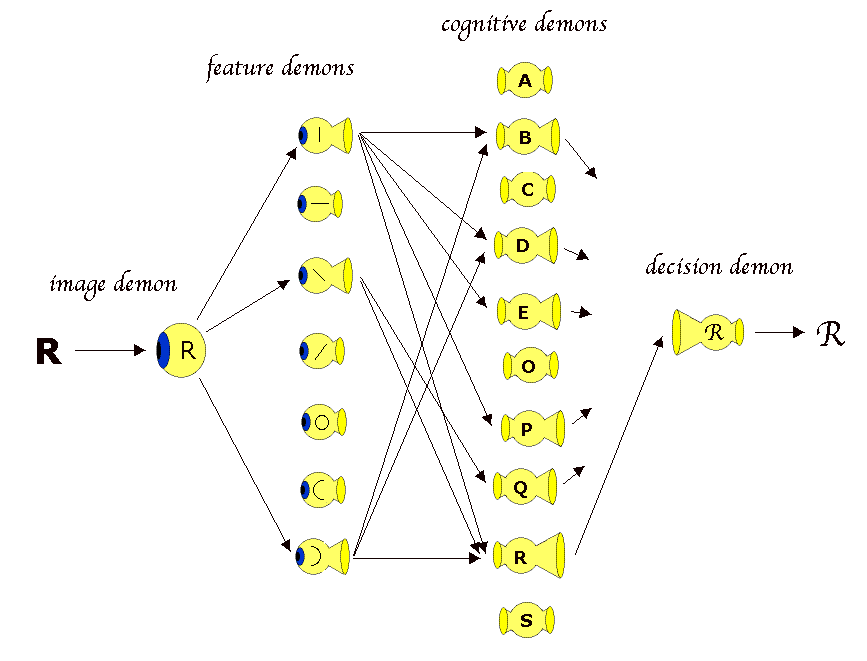
Dr. C. George Boeree
Perception and cognition are not just matters of connections among the neurons or the events, things, features, categories, etc. that those neurons carry. Put another way, we are not true digital computers. It is not a matter of this-or-that and here-or-there. There are also matters of degree, of quantity, intensity, or volume.
Neurons don't just work on the on-or-off principle. They can fire repeatedly, rapidly, or just occasionally or rarely. There can be hundreds of synapses telling a neuron to fire, and hundreds more telling it not to. Likewise, the ideas we have in our minds can be powerful and influence many other ideas, or they can be once-in-a-lifetime flashes of brilliance.
It is important, in order to understand how the mind/brain works, to keep this in mind. One of the most memorable ways of doing this goes back to the early work on artificial intelligence, specifically that of Oliver Selfridge (1959. Pandemonium: A paradigm for learning. In Symposium on the mechanization of thought processes. London: HM Stationary Office).
Selfridge envisioned the mind as a collection of tiny demons, each of whom responds to a name -- or something close to it -- being called out by other demons. When one thinks it is being called, it begins to yell out to other demons. The more certain it is that it is being called, the louder it yells, until some other demon thinks it is being called in turn. And so on. Selfridge called this pandemonium.
He used this idea to explain and model the way perceptual systems
recognize
stuff. For example, the letter R has one vertical line, a "belly"
on the upper right, and a "leg" on the lower right. When "feature
demons" whose names are "vertical," "belly," and "leg" (and others
with names like "one," "upper right," and "lower right") hear their
names
being called, they begin to to call to the "cognitive demons."
The cognitive demons named B and D, for example, may each prick up
their
ears, since they are "sensitized" to such calls as are given out by the
vertical and belly demons. K may be listening, because it is
listening
for the calls of the vertical and leg demons. But only the R
demon
recognizes the calls of all three. So while B, D, and K may be
calling
out to the "decision demon," it will be R who calls the loudest.

This may seem rather silly, but pandemonium provides a very good model for much of what goes on in the mind. The tip-of-the-tongue phenomenon, for example: You are trying to think of the name of that actress in Moulin Rouge. Her name starts with an N, you are certain. Nancy, Nadene, Norah, Natalie... damn. You could say the N demon is yelling, and several names are responding. Nicole! That's it: Nicole Kidman.
Of course, sometimes, with all those N-names yelling at the same time, you just can't hear the one you need! Perhaps Natasha (as in Natasha Richardson -- another favorite of mine!) is shouting so loud, you can hardly hear any other names. If we were purely digital creatures, on-or-off, logical... we would simply remember whatever we needed to remember, and life would be simple, efficient. But perhaps that wouldn't be so good after all...
The world (including ourselves and the people around us) is
extremely
complicated. Our minds are limited, and so need to draw rough
maps
of our world in order to get by. If we were strictly digital,
those
maps would have to be perfect to work: You see R and you say
"R."
But what happens when you see r? Or R? How about
one
of these:
We need to be able to respond to things that are similar, not just things that are a perfect match. In this way, we can generalize our responses, which is how we form categories of things. All cats are not the same, and yet we learn to respond to one particular cat we have never before seen by placing it in the category cat -- thereby giving it a saucer of milk, rather than beating its brains out with a bat.
Likewise, we learn to develop sensitivities to new details (i.e. develop new "feature demons") when we find that we need to discriminate two things we had placed in one category. A bobcat or lynx, for example, is kind of a cat, but one you really shouldn't try to pet.
And this is also how prototypes operate: The neighborhood tabby may be "the" cat. Other cats, though merely approximations, seem to shout out "CAT!" as well. The curly-haired Rex cat, the tailless Manx, the poofy Himalayan, or the hairless Sphynx may take a little closer inspection.
Finally, this imperfect responding allows us to be creative in our perceiving and thinking: We can go with a categorical error (listen to the loud demon who drowns out the one that is more technically correct) and run with it. See what happens. It's a little like evolution: Great ideas are often the result of hundreds of mistakes that turned out well.
© Copyright 2003 C. George Boeree